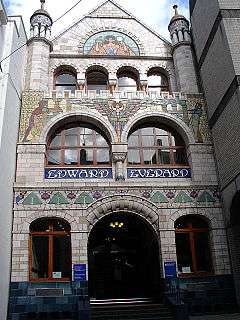Former Everard's Printing Works
| Former Everard's Printing Works | |
|---|---|
 | |
 Location within Bristol | |
| General information | |
| Architectural style | Pre-Raphaelite |
| Town or city | Bristol |
| Country | England |
| Coordinates | 51°27′16″N 2°35′39″W / 51.4545°N 2.5943°W |
| Construction started | 1900 |
| Completed | 1901 |
| Client | Edward Everard |
| Design and construction | |
| Architect | Henry Williams |
The Former Everard's Printing Works (grid reference ST588730) is at 37-38 Broad Street in Bristol, England. It has been designated as a Grade II* listed building.[1][2]
It was built in 1900 by Henry Williams, with the Pre-Raphaelite art nouveau style facade by William Neatby,[3] who was the chief designer for Doulton and Co.,[4][5] as the main works for the printer Edward Everard. It has a triple archway design on the ground floor with two on the first floor and four on the upper floor. Above them is a female figure symbolising Light and Truth.[6] The arches were to reflect the Church of St John the Baptist a little further along Broad Street.[7][8]
Most the red brick building was demolished in 1970 but the arts and crafts facade was preserved as it is the largest decorative Carrara marble tile facade of its kind in Britain.[4][2] The contributions of William Morris and Johannes Gutenberg to printing and literature are celebrated in the design.[9] Behind each figure are typefaces representing their work.[10] After the demolition of the rest of the building the facade was incorporated into a new building which is used as offices by the NatWest bank.[7]
References
- ↑ "Former Everard's Printing Works". Images of England. Retrieved 2007-03-16.
- 1 2 "Former Everard's Printing Works". National Heritage List for England. Historic England. Retrieved 23 October 2016.
- ↑ "Victorian Bristol" (PDF). Brunel 2000. Retrieved 23 October 2016.
- 1 2 "Former Everard's Printing Works, 38 Broad Street, Bristol". Historic England. Retrieved 23 October 2016.
- ↑ "Everard's Printing Works, Bristol". English Buildings. Retrieved 23 October 2016.
- ↑ "Edward Everard Building". About Bristol. Retrieved 23 October 2016.
- 1 2 "Edward Everard's Printing Works". Bristol Past. Building History. Retrieved 23 October 2016.
- ↑ Harvey, Charles; Press, Jon (1994). "A Bristol Printing House: Edward Everard's Monument to Gutenberg, Morris and the Printer's Art" (PDF). The Journal of the William Morris Society. X (4): 40–47.
- ↑ "Everard's Printing Works, Bristol, UK". Manchester History. Retrieved 23 October 2016.
- ↑ "Edward Everard printing works" (PDF). Architecture Centre. Retrieved 23 October 2016.
See also
| Wikimedia Commons has media related to Former Everard's Printing Works. |